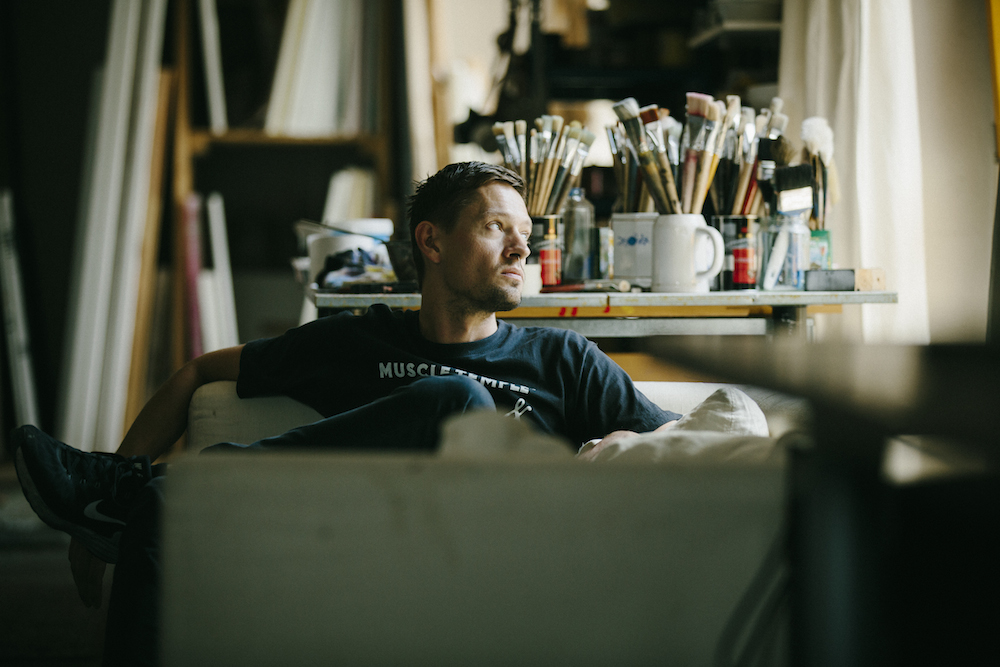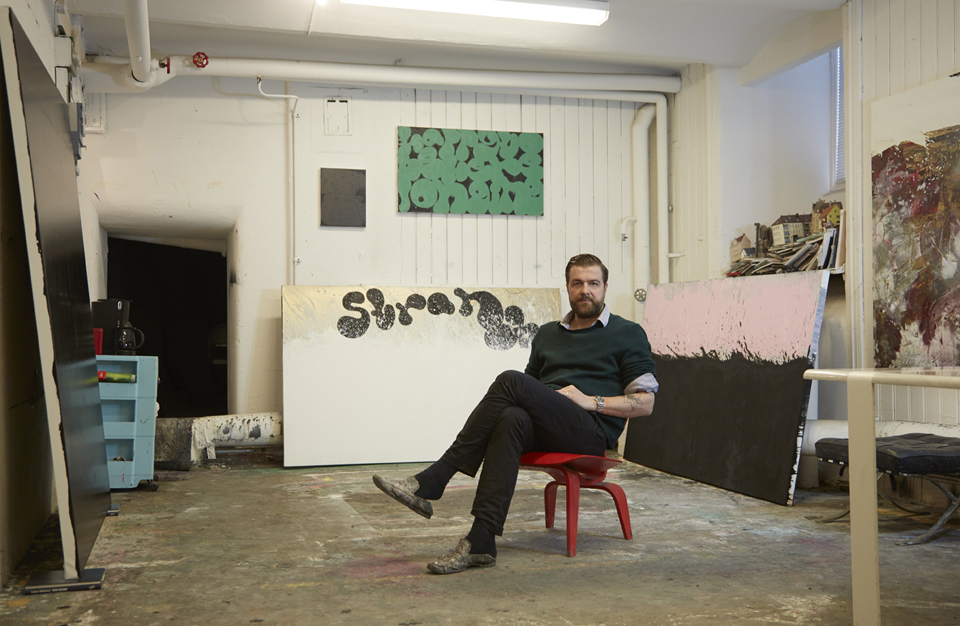Guilty Pleasure, a joint exhibition by Lukas Göthman and Olli Piippo, starts off the Autumn at Helsinki Contemporary. From August 5 to 28, this unique body of paintings will effervesce with the joy of creation, with the focus on the act of painting and the pleasure it brings. Throwing yourself into the process of painting means experimenting and exploring different possibilities, while the finished works radiate pleasure and passion.
The title of the exhibition, Guilty Pleasure, suggests the vice, or literally pleasure, that derives from guilt. For Göthman and Piippo, painting is a strategy for the dissolute, with the act itself guided by gratification. The world of the exhibition conveys an attitude of potent energy that is both inspiring and disturbing.
IN LUKAS GÖTHMAN’S LIFELONG JOURNEY IMAGES ARE DRAWN FROM WORDS
Lukas Göthman’s works are based on text. His paintings created with massive layers of paint incorporate words from the artist’s travel journals, both real and fictional. Göthman’s travel writings are created in places that are in one way or another connected to the past and to remembering. In paintings of various sizes, the words can take the lead or simply echo frames of mind. The relationship of image with word, and with Göthman’s overall working process, induces synaesthesia – a mingling of the senses. The written elements become gestures in the painting, ultimately forming their own language and poetry. The works resemble “expeditions into the wonderful tragedy that is life”, as Göthman says, inviting viewers to make their own journeys.
OLLI PIIPPO’S PAINTINGS DISCOVER A NEW LIGHTNESS AND FREEDOM
Where Göthman draws on text, Olli Piippo bases his work on images that are both personal and found, true and generated by the imagination and memory. These are mixed together in the paintings, which play organically with representational and non-representational elements. In Piippo’s new works we can find familiar, everyday elements that lure viewers back into their own worlds. The artist has tried to shake off the straitjacket of motivation by a single concept or idea. His pieces exude a lightness that seems to well up straight from the core of the painting. Piippo’s work is driven by a playful escapism. He throws himself into the painting process, letting it feed itself.
Seriality is essential to both Göthman’s and Piippo’s work, as is the courage to make mistakes during the working process. One of the underlying themes is the idea that justice will ultimately prevail. The literary device known as poetic justice refers to the consequences caused by individuals themselves in which vices are punished and virtues rewarded – occasionally accompanied by an ironic hiccup. A meaningful act of painting is like a hopeless mission, and Göthman and Piippo have devoted themselves to its nuances with no guarantee of success. The ideas of transience and momentum are also there – as if crystallizing the success that finally emerges of its own accord, despite all the difficulties.
LUKAS GÖTHMAN
The abstract paintings by the Stockholm-resident artist Lukas Göthman (b. 1970) are based on text. Göthman’s paintings are created layer by layer, and depict words from real and imaginary travel journals written by the artist himself. The textual elements become painted gestures, ultimately speaking their own language and poetry. In Sweden this self-taught artist is popular with the general public. His previous solo exhibition, Dreamers and Lovers Drifting, was at Björkholmen Gallery in 2015, and he last showed at Helsinki Contemporary in 2012. His works have been shown in solo and group exhibitions around Sweden and Europe, including Stockholm, Malmö, Amsterdam and Paris.
OLLI PIIPPO
Olli Piippo (b. 1980) lives and works in Berlin. His work is characterized by figurative elements that support a narrative, even if the pieces are mainly based on the experience evoked by the abstract expression. Piippo’s most recent solo exhibition was Staring at the Sea, Standing in the Sand at Forum Box, Helsinki, in 2015, and he participated in the group exhibition Let’s Get Physical at Kunstkraftwerk Leipzig in 2016. His works have been shown in solo and group exhibitions, mainly in Germany, Finland and Sweden. He is also known as the curator of Black Market, which organizes exhibition happenings and events. Art Slant listed him among the ‘15 international curators to watch’ in 2015.
Lukas Göthmanin ja Olli Piipon yhteisnäyttely Guilty Pleasure avaa Helsinki Contemporaryn syksyn. Elokuun 5.–28. nähtävä näyttely on tekemisen iloa hersyvä kokonaisuus, joka keskittyy itse maalauksen tekoon ja siitä nauttimiseen. Maalausprosessiin heittäytyminen on kokeilemista ja eri mahdollisuuksien tapailua, valmiista teoksista välittyy katsojalle nautinto ja intohimo.
Näyttelyn nimi, Guilty Pleasure, viittaa paheeseen tai sananmukaisesti syyllisyydestä ammentavaan nautintoon. Göthmanille ja Piipolle maalaus on strategia paheellisuudelle, ja mielihyvä ohjaa maalaustekoa. Näyttelyn maailmasta välittyy asenteena väkevä energia, joka on yhtä aikaa innostavaa ja häiritsevää.
LUKAS GÖTHMANIN TYÖSKENTELYSSÄ SANA AJAA KUVAA ELÄMÄN MITTAISELLA MATKALLA
Lukas Göthmanin työskentely pohjautuu tekstiin. Kerros kerrokselta massiivisista maalikerroksista rakentuvat maalaukset esittävät sanoja taiteilijan kirjoittamista, todenmukaisista ja kuvitteellisista, matkapäiväkirjoista. Göthmanin matkakirjoitukset syntyvät paikoissa, jotka liittyvät tavalla tai toisella menneisyyteen ja muistamiseen. Erikokoisissa maalauksissa sanat voivat olla johdattelevia, tai vain kuin mielentilojen kaikuja. Kuvan ja sanan suhde sekä Göthmanin kokonaisvaltainen työskentelyprosessi tuovat mieleen synestesian, aistien sekoittumisen. Kirjallisista elementeistä tulee maalauksen eleitä jotka puhuvat lopulta omaa kieltään ja runouttaan. Teokset ovat kuin "tutkimusretkiä elämän ihanaan tragediaan", sanoo Göthman, houkutellen yleisöä omille tutkimusretkilleen.
TEKEMISEN VAPAUS LÖYSI TIENSÄ OLLI PIIPON UUSIIN MAALAUKSIIN
Siinä missä Göthman ammentaa tekstistä, Olli Piipon työskentely pohjaa erilaisiin henkilökohtaisiin ja löydettyihin, todellisiin sekä mielikuvituksen ja muistojen synnyttämiin kuviin. Nämä sekoittuvat esittävillä ja ei-esittävillä elementeillä orgaanisesti leikittelevissä maalauksissa. Teoksista voi löytää arkisia ja tuttuja elementtejä, jotka houkuttelevat katselijan omiin maailmoihinsa. Uusissa teoksissaan taiteilija on kuitenkin pyrkinyt luopumaan konseptin tai tietyn idean ajamasta maalausprosessin pakkopaidasta. Pelkistetyt teokset huokuvat kepeyttä joka kumpuaa kuin suoraan maalauksen ytimestä. Piipon työskentelyä ajaa leikittelevä eskapismi. Hän heittäytyy maalausprosessin vietäväksi ja antaa sen ruokkia itse itseään.
Göthmanin ja Piipon taiteessa keskeistä on sarjallisuus, ja uskallus sortua virheaskeliin työskentelyprosessin aikana. Yksi kantavista teemoista on ajatus oikeudenmukaisuuden lopullisesta toteutumisesta. Kirjallisuudesta tuttu tyylillinen tehokeino poetic justice viittaa henkilön itsensä omista valinnoista aiheutuviin seuraamuksiin, kun paheista rangaistaan ja hyveistä palkitaan – toisinaan ironisen nyrjähdyksen saattelemana. Merkityksellinen maalausteko on kuin toivoton tehtävä, jonka nyansseihin Göthman ja Piippo ovat omistautuneet ilman onnistumisen takuuta. Tähän liittyy ajatus hetkellisyydestä ja momentumista – kuin onnistumisen kiteytymästä, joka lopulta syntyy kuin itsestään kaikesta vaikeudesta huolimatta.
LUKAS GÖTHMAN
Tukholmassa asuvan ja työskentelevän Lukas Göthmanin (s. 1970) abstraktit maalaukset pohjautuvat tekstiin. Hänen kerros kerrokselta rakentuvat maalaukset esittävät sanoja taiteilijan kirjoittamista, todellisista ja kuvitteellisista, matkapäiväkirjoista. Kirjallisista elementeistä tulee maalauksen eleitä jotka puhuvat lopulta omaa kieltään ja runouttaan. Itseoppinut taiteilija on kotimaassaan Ruotsissa suuren yleisön suosiossa. Hänen edellinen yksityisnäyttelynsä Dreamers and Lovers Drifting esitettiin Björkholmen Galleryssa 2015, ja edellinen näyttelyn Helsinki Contemporarysssa nähtiin 2012. Göthmanin teoksia on lisäksi nähty yksityis- ja ryhmänäyttelyissä eri puolilla Ruotsia ja Eurooppaa, mm. Tukholmassa, Malmössa, Amsterdamissa ja Pariisissa.
OLLI PIIPPO
Olli Piippo (s. 1980) on Berliinissä asuva ja työskentelevä taiteilija, jonka maalauksissa tarinankerrontaa tukevat figuratiiviset elementit, vaikka teokset pääasiassa luottavatkin abstraktin ilmaisun tuottamaan kokemukseen. Piipon edellinen yksityisnäyttely Staring at the Sea, Standing in the Sand nähtiin Forum Boxissa 2015, ja hän osallistui Let's Get Physical ryhmänäyttelyyn Kunstkrafwerk Leipzigissä keväällä 2016. Lisäksi Piipon teoksia on nähty yksityis- ja ryhmänäyttelyissä pääasiassa Saksassa, Suomessa ja Ruotsissa. Hänet tunnetaan myös näyttelytapahtumia järjestävän Black Market -sarjan kuraattorina, ja Art Slant nosti hänet kansainväliselle ”15 curators to watch” -listalleen vuonna 2015.
Lukas Göthmans och Olli Piippos samutställning Guilty Pleasure öppnar hösten på Helsinki Contemporary och presenteras 5.–28. augusti. Helheten som bubblar av skaparglädje är koncentrerad runt själva måleriprocessen och runt att njuta av den. Att kasta sig i processen är att experimentera och treva efter olika möjligheter. De färdiga verken förmedlar vällust och passion.
Utställningens namn, Guilty Pleasure, syftar bokstavligen på vällust som hämtar från skuld. För Göthman och Piippo är målningen en strategi för oanständighet, och vällusten styr målandet. Utställningens värld förmedlar som attityd en kraftig energi, som samtidigt är både inspirerande och störande.
I LUKAS GÖTHMANS ARBETE DRIVER ORDET BILDEN PÅ EN LIVSLÅNG RESA
Lukas Göthmans arbete grundar sig på text. Målningarna som är uppbyggda av massiva skikt av målfärg presenterar ord ur konstnärens resedagböcker, verkliga och uppdiktade. Göthmans reseskildringar föds på ställen som på ett eller annat sätt är anknutna till det förflutna och till att minnas. I de olika stora målningarna kan orden vara ledande eller blott som ekon av olika sinnestillstånd. Relationen mellan bild och ord, samt Göthmans heltäckande arbetsprocess, påminner om synestesi, sammankoppling av sinnen. De skriftliga elementen blir målningens gester, vilka slutligen talar sitt eget språk och sin egen poesi. Verken är som expeditioner till "livets underbara tragedi", säger Göthman och lockar åskådarna på egna expeditioner.
SKAPANDEFRIHETEN FANN OLLI PIIPPOS NYA MÅLNINGAR
Där Göthman hämtar från texten, grundar sig Olli Piippos arbete på olika personliga och upptäckta, såväl verkliga som fantasi- och minnesbaserade bilder. Dessa blandas i målningarna, som organiskt leker med föreställande och abstrakta element. I verken kan man finna vardagliga och bekanta element, som lockar åskådaren in i verkens värld. I sina nya verk har konstnären emellertid strävat till att avstå från måleriprocessens tvångströja, i vilken man driver ett visst koncept eller en viss idé. De enkla verken utstrålar en lätthet som verkar välla direkt ur målningens kärna. En lekfull eskapism driver Piippos arbete. Han kastar sig i måleriprocessen och låter den föda sig själv.
Göthmans och Piippos konst grundar sig på seriellt tänkande och modet att ta felsteg under arbetsprocessen. Ett av de bärande teman är tanken om att rättvisan slutligen blir verklighet. Poetic justice är ett litterärt effektmedel i vilket personens egna val leder till följder där synd bestraffas och dygd belönas – då och då åtföljda av en ironisk händelse. Meningsfullt måleri är som en hopplös uppgift, vars nyanser Göthman och Piippo har ägnat sig åt utan garantier för framgång. Detta anknyter till tanken om flyktighet och momentum – likt en kristallisation av framgång, som till sist föds som av sig själv trots alla svårigheter.
LUKAS GÖTHMAN
Lukas Göthman (f. 1970) bor och arbetar i Stockholm. Hans abstrakta målningar grundar sig på text. De skikt för skikt uppbyggda målningarna innehåller ord från verkliga och uppdiktade resedagböcker som konstnären skrivit. De skriftliga elementen blir gester i målningen, som slutligen talar sitt eget språk och sin egen poesi. Hemma i Sverige är den självlärda konstnären populär bland den breda allmänheten. Hans senaste separatutställning, Dreamers and Lovers Drifting, ställdes ut på Björkholmen Gallery 2015, och på Helsinki Contemporary visade han senast 2012. Göthmans verk har dessutom presenterats i separat- och grupputställningar på olika håll i Sverige och Europa, bland annat Stockholm, Malmö, Amsterdam och Paris.
OLLI PIIPPO
Konstnären Olli Piippo (f. 1980) bor och arbetar i Berlin. Även om hans målningar huvudsakligen förlitar sig på upplevelsen som den abstrakta framställningen framkallar, innehåller de figurativa element som stöder berättandet. Piippo presenterade sin förra separatutställning, Staring at the Sea, Standing in the Sand, på Forum Box 2015, och våren 2016 medverkade han i grupputställningen Let's Get Physical på Kunstkraftwerk Leipzig. Hans verk har dessutom ställts ut i separat- och grupputställningar huvudsakligen i Tyskland, Finland och Sverige. Piippo är också kurator för Black Market, som ordnar utställningsevenemang.


Share this exhibition